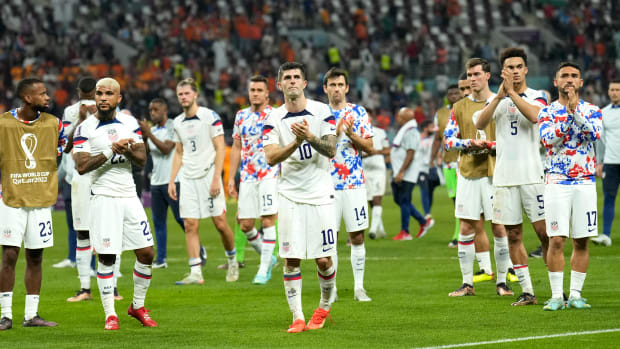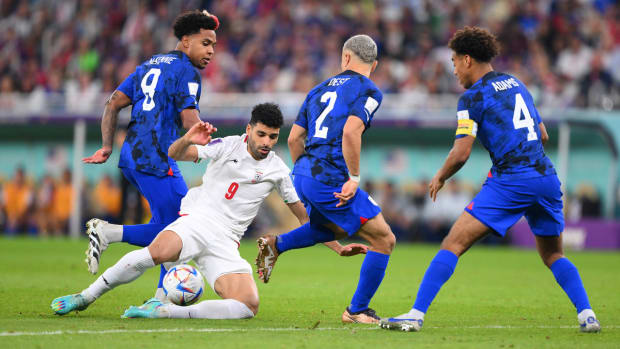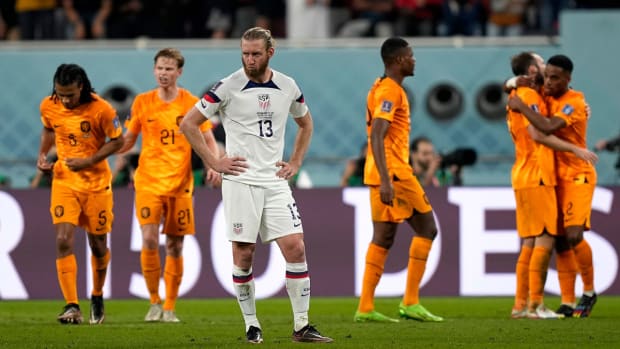AL RAYYAN, Qatar — Throw out the disastrous 2018 cycle—it was a historic outlier blighted by mismanagement—and it’s easy to simply look at the stats and fear the U.S. men have come up against their soccer ceiling.
In three straight World Cups, the Americans escaped the group stage with a single win over an African or Asian opponent only to fall in the round of 16. All three knockout-round matches were close, either in the run of play, on the scoreboard or both. The U.S. lost to Ghana (2010) and Belgium (2014) in extra time, and then were ousted by the Netherlands on Saturday here in Qatar, 3–1, despite an advantage in shots and possession.
Climbing through the hierarchy is difficult, and it’s a generational project. The U.S. already has done it once—progressing from the global hinterlands to become a program that’s regularly ranked in FIFA’s top 20, expects to qualify for the World Cup and then get out of its group. And it has company. Mexico, Chile, Colombia, Denmark, Japan and Switzerland are examples of nations that seem, more or less, on a similar level. El Tri, of course, was the face of that cohort for decades, losing in the second round for seven consecutive World Cups before leaving early this time around.
The question confronting the U.S. as it departs Qatar, then, is whether this round-of-16 elimination is different from the others. Does it represent progress, or is it more of the same?

Francisco Seco/AP
On Saturday night, despite the sadness and frustration that followed the defeat to the Netherlands, there was resolute conviction that this cycle was just the beginning. The U.S. was the second-youngest team in Qatar and, through Saturday’s matches, U.S. coach Gregg Berhalter had fielded four of the tournament’s five youngest starting lineups. The number of players who will be entering their prime over the next four years, leading to the North American World Cup in 2026, far exceeds the number who will be aging out.
“Clearly,” said Christian Pulisic when asked if the team had progressed. “We didn't qualify for the last World Cup, and here we are in the round of 16. We’ve definitely come a long way. Right now it just hurts after a tough loss like that. We feel like we could have had more.”
Pulisic will be 27 at the ’26 World Cup, and he enjoyed a promising debut. He was involved in all three U.S. goals—setting up Tim Weah against Wales and Haji Wright against the Dutch and then scoring the winner himself in the group stage finale against Iran. And although he wasn’t perfect, he was active. His four shot-creating actions per 90 minutes led the U.S. and ranked 31st overall as of Saturday night. Only one player has drawn more fouls, and Pulisic hit more crosses than any player at the World Cup (the lack of a reliable target isn’t his fault.)
"It's another experience for all these guys,” Pulisic said Saturday. “There’s for sure moments that we can be proud of. But we don't want to feel like this again, and we want to put ourselves in a position to win tournaments like this.”
Defender DeAndre Yedlin, now 29, was the one player on the U.S. roster with World Cup experience, and he likely won’t be around for another. He knows the benefit of that seasoning.
“The biggest thing is, the group learned what it feels like to lose in a World Cup, and that goes a long way,” the Inter Miami veteran said. “Now you’re going into the next one and pretty much everybody in that group probably will have played in a World Cup. So now it's a whole different story.”

Ulmer/Teamfoto/Imago Images
Yedlin was exaggerating slightly in the moment, of course. “Pretty much everybody” may not happen (only Iran’s World Cup squad averaged over 29—four years older than the U.S.). Sergiño Dest, Gio Reyna, Yunus Musah and Brenden Aaronson are among those who will still be 25 or younger by the next World Cup. But not only do individual form and fortunes rise and fall, new players come through. Among those who just missed the flight to Qatar are striker Ricardo Pepi (now 19), injured center back Chris Richards (22) and midfielder Malik Tillman (20). The young man who’s considered by some to be the future of American goalkeeping, Gabriel Slonina, is just 18. The top tier of this U.S. team is good, but there’s a lack of depth, especially in midfield, that can only be resolved through continued talent development (nine men started all four games). There will be auditions at center back and striker almost immediately.
But there will be opportunities to identify those players. There’s a U-23 Olympic tournament in 2024. The U.S. U-20s have won three straight Concacaf championships and will be competing at that World Cup next spring. MLS and USL academies, and the widening pipeline between the U.S. and European clubs that are now increasingly interested in talented bargains, will forge more talent and push those new World Cup veterans hoping to return in 2026.
The “grandpa” of this U.S. group, 35-year-old center back Tim Ream, has been telling his younger teammates not to take anything for granted.
“I've tried to convey that to the guys. You're never guaranteed anything in this game. I’ve been in the program for 12 years and was never guaranteed anything,” he said Saturday.
“Trying to convey to treat each and every training session as if it was their last, each and every game as if it was their last,” Ream continued. “Tomorrow if it all finished and their career was done, would they be happy with it? And I can honestly say, if that was the case for me, ‘Yes.’ I've given it everything and I hope these guys take that advice, because I think it's something that's important: not taking anything for granted. And I've seen them take that advice in these three weeks that we've been together. I hope they continue to do that.”

Martin Meissner/AP
The next cycle will be unlike any in American soccer history. The last time the U.S. qualified automatically as World Cup host, there was no professional league, no developmental foundation and no national soccer culture. Now, U.S. Soccer will have to find a way to maintain this group’s trajectory while introducing new faces as they emerge. The first question confronting sporting director Earnie Stewart is Berhalter’s status. The coach’s contract expires at the end of the month. The second concern will be competitive.
The U.S. will be back in its Concacaf backyard for the majority of next year as it defends its Nations League and Gold Cup titles. Some of the younger players may want to give the Olympics a shot in ’24, but the real intrigue that summer surrounds the speculation that some or all of the three North American World Cup hosts—the U.S., Mexico and Canada—might try to get involved in the next Copa América. A lot of the long-term schedule depends on how Concacaf and FIFA restructure their international calendars. A 2025 Gold Cup is tentatively on the horizon, but a World Cup “test event” might also be a possibility that summer. FIFA organized a competition for national teams from the Arab world here in Qatar last winter, for example.
The challenge will be to find competition outside the relentless repetition of Concacaf. Following Saturday’s defeat, the U.S. is now 1-12-7 against European foes at the World Cup since returning to the tournament in 1990.
Somehow, during the next three-plus years, this young, promising core needs to figure out how to get closer to beating the elite. There’s a clear, team-first culture in place, and the ages are just right. Perhaps time will take care of the rest.
“When you look at the difference of the two teams, to me there was some offensive quality, offensive finishing quality, that Holland had that we were lacking a little bit,” Berhalter said Saturday. “It's time. It’s normal. We have a very young group. We have players that are beginning their careers and they're gonna catch up to that.
“Can we win against top teams? Can we perform well against top teams—well enough to win? I think, again, [the Netherlands game] is a strange type of outcome in a game like this, when we performed really well, especially in the first half. So I think this group is close,” Berhalter added. “To be fielding the youngest lineups in the World Cup … and still be able to play the way we are, the American public should be optimistic.”
Ream certainly is.
“It's guys who are 22, 23, 24 years old who are not even hitting their prime yet,” he said. “The potential is just huge going into this next cycle, and the program’s in good hands with these guys: good characters, good players, good people. I got to see it first-hand after being away [from the national team] for a year and I'm excited for the future. I'm excited for these guys. I'm excited for what they're going to be able to do on the world stage.”







